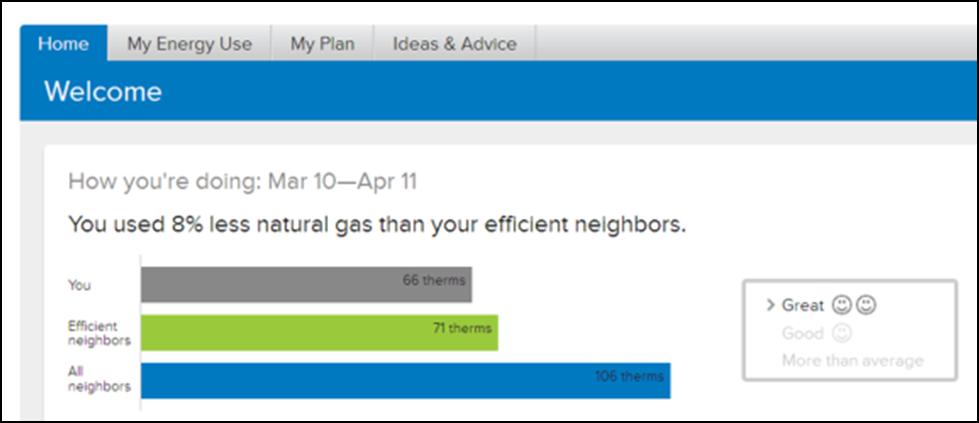Understanding your energy use is a powerful thing. And when you find your utility bills driven up by summer air-conditioning or winter heating, the right tools (and a little competitive drive) can help.

More energy savings equals more smiley faces. Life is good.
Keeping down with the Joneses
Our natural gas utility recently started sending us monthly info on how our usage stacks up against our neighbors’—the average of 100 comparable nearby homes, and the best 20 percent. The idea is that if we the people have more information about how much energy we’re gulping down—and whether our neighbors are beating us—we’ll improve. Raw number comparisons, plus focus group-tested graphics (in our case, smiley faces), are supposed to motivate choices, big and small, that move us in the right direction.
And it sure works in my case. When our monthly results come in, I’ll admit I feel like I’m back in third grade and competing for a gold star sticker on my homework. But, man, I want that double smiley face, every month. What else can I insulate? What more can I do to tighten up the house? (How much further can I convince my wife to let me drop the thermostat during our winter slumbers?)
It turns out this kind of feedback works for others, too. Our new book Cooler Smarter talks about an Arizona utility that did just two simple things to help customers get more in tune with how much electricity they were using. They had customers pay upfront for their electricity in chunks, the same way we gas up our cars. And they gave them real-time information about their usage.
The results were impressive: those two simple moves alone got people to cut their electricity by an average of 12 percent. Pretty cool.
And National Geographic cites one advocate of getting people more information as saying that “[m]ore than 75 percent of the people who get the enhanced reports do something to measurably reduce their energy use.”

If you think Bela Lugosi was scary, check to see how much electricity your TV is drawing when it’s “off”. Source: www.bmovienation.com
Keeping tabs
If knowledge is power, then more knowledge must be even more power. And now the power is mine, all mine. [Insert maniacal laughter.] As part of the energy efficiency work we’ve been doing at home, we’ve just installed a new system that gives me more info than I could possibly digest. It monitors our different electric circuits individually, telling us about active use on each, plus vampire loads—things that are sucking juice even when we’re not using them.
And right away the knowledge was empowering and motivating. Since we got the equipment installed, I’ve been checking it frequently to see what was going on. I’m riveted by the numbers, entranced by its portrayal of the ebb and flow of our household electricity use, and pumped by the possibilities the data suggested. (Did I mention I’m an engineer?)
It turns out that the 8-watt vampire load I found with a plug-in meter not long ago was just the vanguard of the voracious vampire squad. I’d now unearthed a whole graveyard of Undead. I’m sharpening my stakes even as I write this, readying the hunt.
Keeping it real

Vampires have no place to hide.
But you don’t have to go that deep, or lose sleep, to feel the power. If your utility offers bill comparisons, that’s handy. If they have a smart meter program, even better. But even without those things, you can still watch your bills, using your own usage history as your motivating benchmark. And you can buy or borrow from your library one of those plug-in meters to zero in on particular appliances. You can find energy hogs, vampires, and a whole new source of power and inner peace.
In the meantime, if you’re looking for me, I’ll be staring at the screen analyzing the output from our new energy monitor, or running around the house with my boys, finding other energy hogs to drive out.
Warn the neighbors: we’re planning to be the ones to beat. Those smiley faces are ours.
